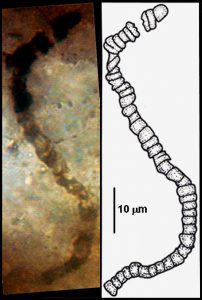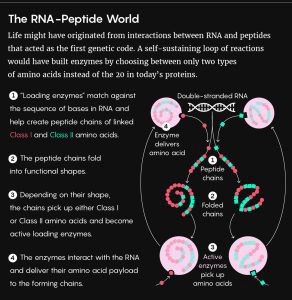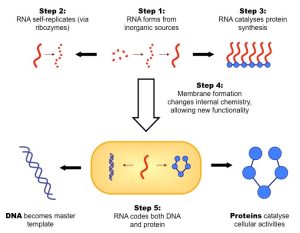
Table of Contents
Toggle7.13 Origin of Life on Earth
The origin of life on Earth is a topic of ongoing scientific research, with several intriguing hypotheses proposed to explain how life first emerged. These hypotheses are supported by diverse types of scientific evidence, including geological, chemical, and biological clues. Let’s take a journey back in time to explore the origin of life on our planet. 🌎
When Did Life Start?
Geological evidence provides essential support for models of life’s origin by revealing information about Earth during its early history. We know that Earth formed approximately 4.6 billion years ago (bya), and the environment was too hostile for life until about 3.9 bya. This understanding comes from geological records, such as the composition of the early atmosphere, the presence of liquid water, and the sun’s radiation intensity. By understanding these conditions, scientists are able to construct models of how life could have emerged under these circumstances.
The earliest fossil evidence for life on Earth dates back to around 3.5 billion years ago. Fossilized stromatolites, layered structures formed by ancient microbial communities, provide strong evidence that life existed at least 3.5 billion years ago. They also give insight into the nature of that early life. Together, the geological and fossil evidence helps scientists frame a plausible timeline of when life could have emerged on Earth, roughly between 3.9 and 3.5 billion years ago.

Modeling Life’s Origin
There are several models for how life first emerged on Earth, falling broadly into two categories: abiogenesis and panspermia.
One of the leading models of abiogenesis is the “primitive Earth” hypothesis. It proposes that life emerged on Earth through the gradual synthesis of organic molecules from inorganic precursors. The primitive Earth had the necessary conditions for this synthesis—available free energy, absence of significant atmospheric oxygen, and abundant water. This model suggests that the first living organisms were simple, self-replicating molecules that formed spontaneously in the early Earth’s oceans. 💎
Another model, panspermia, suggests that organic molecules were transported to Earth by meteorites or other celestial bodies. These molecules, such as amino acids and nucleotides, could have formed in the dust clouds of other planets or within comets and then been transported to early Earth, where they formed the building blocks of life. This model proposes that the ingredients for life may have extraterrestrial origins. ☄️
Current scientific understanding suggests that multiple mechanisms might have contributed to the origin of life, with both abiogenesis and panspermia playing potential roles. It is possible that both inorganic precursors formed on Earth and organic molecules were brought by meteorites, contributing to the emergence of life.
What Does the Chemistry Tell Us?
Chemical experiments have shown that complex organic molecules can form from inorganic molecules without the need for life. This process is known as abiogenesis, which explores how life can emerge from non-living matter.
One of the key aspects of these experiments is the formation of organic molecules (monomers) from inorganic precursors. These organic molecules, such as amino acids and nucleotides, served as building blocks for the formation of more complex molecules. Scientists have demonstrated that these organic molecules can form under conditions similar to those believed to have existed on early Earth—conditions involving energy availability and the absence of significant atmospheric oxygen.
These monomers joined to form polymers, which are long chains of repeating units. These polymers are capable of replicating, storing, and transferring information, which are essential hallmarks of life. For example, nucleic acids (DNA and RNA) store genetic information, while proteins (such as enzymes) catalyze chemical reactions. The formation of these polymers was a critical step in the emergence of life, as they enabled the replication and evolution of the first living organisms.
RNA’s Role in the Puzzle
The RNA World Hypothesis is a widely accepted model for the origin of life that proposes RNA could have been the earliest genetic material. According to this hypothesis, RNA was the first molecule capable of storing and transmitting genetic information, catalyzing chemical reactions, and replicating itself.

The RNA World Hypothesis suggests that RNA molecules were the first self-replicating entities on Earth and that they eventually gave rise to more complex forms of life, including DNA and proteins. RNA was likely a versatile molecule that performed all three essential functions of life: storing genetic information, catalyzing chemical reactions, and self-replicating. 🌱
One of the key pieces of evidence supporting this hypothesis is RNA’s ability to act as both a genetic molecule and a catalyst. Scientists have shown that RNA can catalyze a wide range of chemical reactions, including those critical for life, such as nucleotide polymerization, peptide bond formation, and sugar synthesis. This suggests that early RNA could have facilitated the formation of more complex molecules and replicated itself, paving the way for the emergence of life.

Recent Posts
- 1.4 Understanding and interpreting a narrator’s perspective
- 1.3 Understanding how a story’s structure affects interpretations
- 1.2 Identifying and interpreting setting
- 1.1 Interpreting the role of character in fiction
- Unit 1 Overview: Introduction to Short Fiction
- Laws of Indices – Number & Algebra – IB Mathematics AA HL
- Standard Form – Number & Algebra – IB Mathematics AA HL
- 9.2 Crafting an argument through stylistic choices like word choice and description
- 9.1 Strategically conceding, rebutting, or refuting information
- Unit 9 Overview: Developing a Complex Argument
- 8.4 Considering how style affects an argument
- 8.3 Considering how all choices made in an argument affect the audience
- 8.2 Considering how sentence development and word choice affect how the writer is perceived by an audience
- 8.1 Choosing comparisons based on an audience
- Unit 8 Overview: Stylistic Choices
Choose Topic
- ACT (17)
- AP (20)
- AP Art and Design (5)
- AP Physics 1 (1)
- AQA (5)
- Artificial intelligence (AI) (2)
- Banking and Finance (6)
- Biology (13)
- Business Ideas (68)
- Calculator (72)
- ChatGPT (1)
- Chemistry (3)
- Colleges Rankings (48)
- Computer Science (4)
- Conversion Tools (136)
- Cosmetic Procedures (50)
- Cryptocurrency (49)
- Digital SAT (3)
- Edexcel (4)
- English (1)
- Environmental Science (2)
- Exam Updates (1)
- Finance (17)
- Fitness & Wellness (164)
- Free Learning Resources (209)
- GCSE (1)
- General Guides (40)
- Health (107)
- History and Social Sciences (152)
- IB (1)
- IGCSE (2)
- Image Converters (3)
- IMF (10)
- Math (39)
- Mental Health (58)
- News (8)
- OCR (3)
- Past Papers (463)
- Physics (5)
- SAT (39)
- Schools (3)
- Sciences (1)
- Short Notes (5)
- Study Guides (28)
- Syllabus (19)
- Tools (1)
- Tutoring (1)

